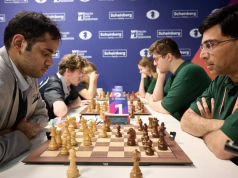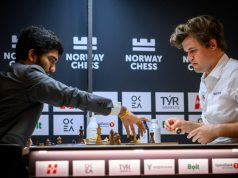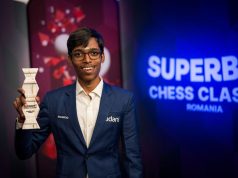In our series Champion Born On This Date, today we are featuring Mikhail Botvinnik, the pioneer of artificial intelligence and someone who is considered to be the greatest Chess visionary.
Growing up in the USSR
Mikhail Botvinnik was born on 17th August, 1911 at Kuokkala in erswhile USSR to a Jewish dentist couple. Though it was the most trying time then for the Jewish community, yet Botvinnik always found a way to survive and excel due to his intelligence, adaptability and wisdom.
Botvinnik turned an atheist at a young age and always described himself as “a Jew by blood, a Russian by culture and a Soviet by upbringing”.
Mikhail Botvinnik- Carried forward the chess legacy
At the tender age of 20, Botvinnik won the Soviet Chess Championship, thereby getting opportunity to participate in important Chess tournaments in Western Europe. His victories over former World Champions Capablanca and Alekhine revealed the depth of his mastery over Chess strategy, tactics and technique
When world champion Alexander Alekhine passed away in 1946, leaving the Chess throne empty, the International Chess Federation (FIDE) conducted the ‘World Championship Tournament’ at Groningen. Botvinnik emerged as the winner in that tournament and was crowned as the World Champion for the first time.
Mikhail Botvinnik- The father of computer chess
Mikhail Botvinnik always believed in propagating and promoting the game on all fronts at the same time. He was the main force behind the government support and the broad player base in Soviet Union. He wrote several Chess books and composed some very illustrative Chess puzzles.
However, Botvinnik’s greatest contribution to Chess is his study of artificial intelligence and computer science. Even when he was the World Champion, he dedicated a lot of time in designing and making Chess playing computers.
Even at the risk of becoming ridiculed by fellow Chess masters, Mikhail Botvinnik always expressed that computers would eventually defeat humans some day. His words have indeed come true, though, sadly, it was not to happen during his lifetime.
The true leader
After retiring from active participation in world championship cycles, Botvinnik started training talented youngsters from Soviet Union. World champions Garry Kasparov and Vladimir Kramnik are the most prominent among his students.
Botvinnik promptly acknowledged the contribution of others to his own work as well as to Chess theory. He attributed his concept of ‘acclimatisation’, practiced by all Soviet sportpersons for decades, to invaluable inputs and suggestions by World Chess Champion Dr Emanuel Lasker.
Due to his innovations, objectivity and clarity of thoughts, Botvinnik was always able to lead the Chess world in new directions and dimensions till the last day of his life. The Chess world will always miss this legendary personality.
Learn from the Champion
Today let me take you through a game played by Botvinnik in the system named after him and annotated by none other than his most successful pupil, Garry Kasparov.
Arnold Sheldon Denker-Mikhail Botvinnik
Radio Match USSR- USA, 01.09.1945
1.d4d52.c4e63.Nc3c64.Nf3Nf65.Bg5dxc46.e4b5
This sharp continuation, defending the ‘c4’ Pawn at the cost of allowing White to attack the pinned Black Knight with a Pawn, is now known as the Botvinnik variation of the Slav Defence.
7.e5h68.Bh4g59.Nxg5!hxg510.Bxg5Nbd711.exf6
White has recovered the sacrificed piece and seems to be in an advantageous position. However, Botvinnik soon demonstrated that this is only an illusion and Black has enough dynamic resources to create adequate counterplay.
11…Bb712.Be2?
This natural developing move turns out to be a serious mistake.
“12.g3! must go without thinking- writes my hand 51 years later.”- Garry Kasparov in 1996.
12…Qb613.0–00–0–0
“Both kings are castled ; however, the White monarch will soon feel quite uncomfortable, especially after the immanent c6–c5.” – Garry Kasparov.
14.a4?!
“Looks natural, but while trying to open the opponent’s Kingside White soon finds himself well behind in the creation of any real threats.” – Garry Kasparov.
“14.Bf3 protecting the crucial diagonal, could have partially repaired the damage done by the 12th move, although a bishop on g2 with the pawn on g3 is a much more healthy construction for the castled King, For example, 14…Ne5!? leads to a double-edged position after the queen sacrifice: 15.dxe5 Rxd1 16.Rfxd1 ” Garry Kasparov.
“In one training game Ragozin, Botvinnik’s long-time coach and sparring partner, played the optimistic 14.h4 and after 14…Bh6! 15.a4 Bxg5 16.hxg5 b4 17.Ne4 c5 White didn’t survive for long in this open position.” – Garry Kasparov.
14…b4!15.Ne4c5!16.Qb1?
“Too far from the action. 16.Qc2 wouldn’t have changed much after 16…b3! 17.Qb1 Qc7 etc. Another proposition 16.Qc2,c3!?17.bxc3Qc7 looks extremely exciting, e.g.18.f4cxd419.c4d3! 20.Bxd3 Nc5 21.Nxc5 Bxc5+ 22.Kh1 Rdg8 (threatening 23…Rxg5) 23.Bh7 (what else?) 23…b3! 24.Qb1, Qc6! 25.Rf3 Qxf3! and the crazed elephants (Chess Bishops are called elephants in Russian) will trample all over White’s king. Remember 26.gxf3 Bxf3# is mate!” – Garry Kasparov.
The only reasonable alternative was 16.Nd2!with hopes of staying in the game after 16…c3
17.bxc3bxc318.Nc4Qc719.h4etc.
16…Qc7!
As you have probably noticed, Black has gained a valuable tempo for manoeuvring his queen, because the square h2 is also vulnerable from the diagonal h2–b8.
17.Ng3?
“The final mistake. This knight had to stay one 4.
The alternative 17.h4 wouldn’t stop Black’s attack after 17…Bh6!;
17.g3!was relatively the best and could have prevented immediate disaster.” – Garry Kasparov.
17…cxd418.Bxc4!Qc6!
But not 18… Qxc4?? due to 19.Rc1.
19.f3d3!
“In amazing harmony Black’s pieces are using all open lines and diagonals to satisfy their “basic instincts”: to get at the White king!” – Garry Kasparov. Black opens up the ‘g1–a7’ diagonal for his King Bishop.
20.Qc1
Bad is 20.Ne4?Qc7!21.g3Bxe4!22.fxe4Qxc4 23.Rc1Bc5+24.Kf1Qxe4 with a rapid mate. Or if 20.Be3 then 20….Bc5 21.Qe1 Ne5 22.Bb3 Ng4! and White wins.
20…Bc5+21.Kh1Qd6!22.Qf4
This allowed Black to win with a pretty combination but there was no defence anyway.
22…Rxh2+!23.Kxh2Rh8+24.Qh4
24.Nh5failsto24…Rxh5+25.Kg3Rxg5+!
24…Rxh4+25.Bxh4Qf4!
Whiteresigned.0–1




